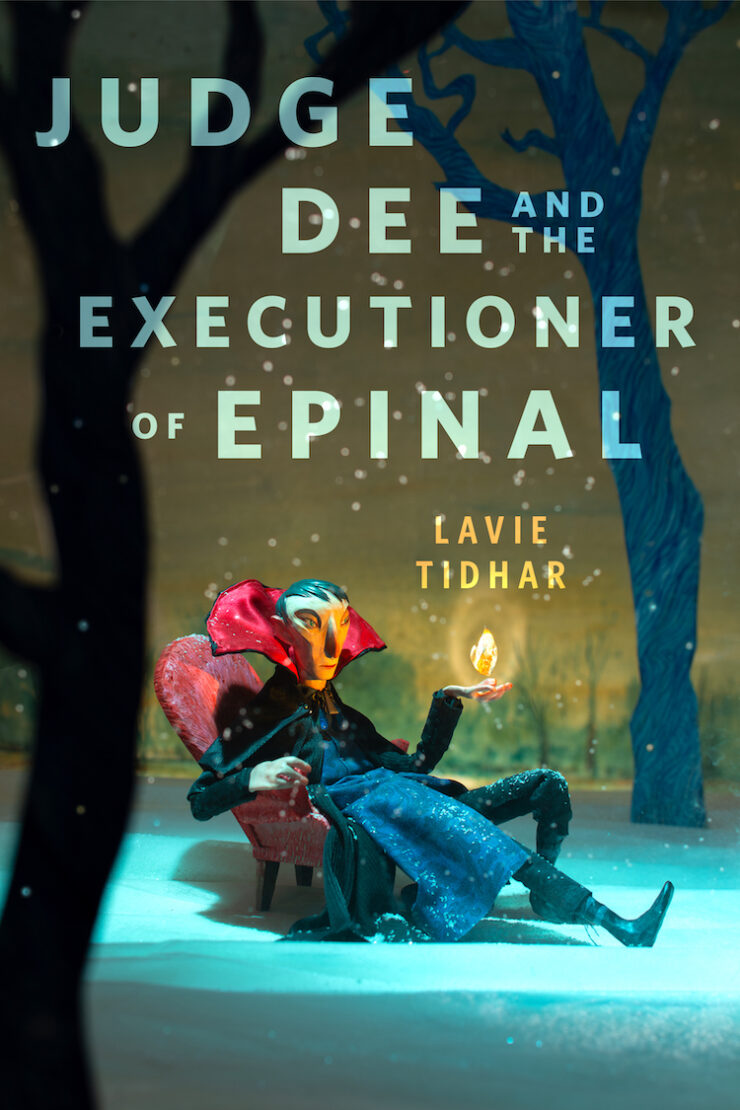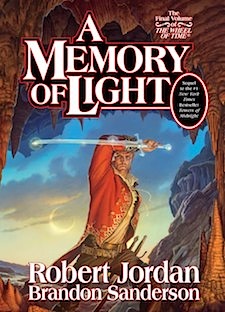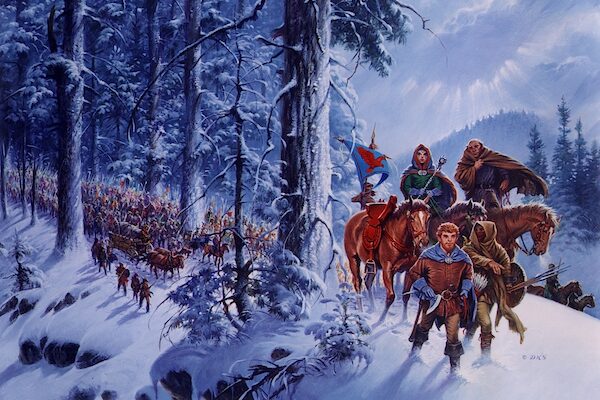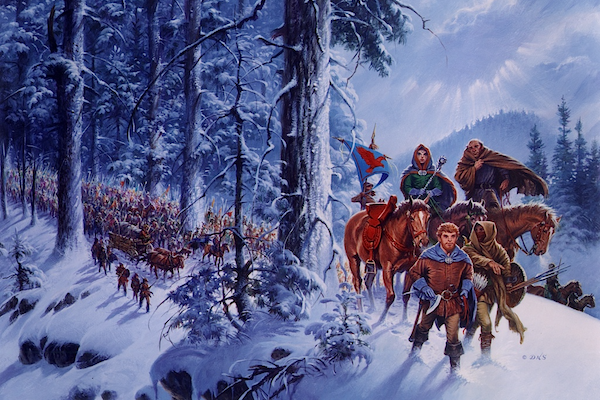Calm thy twitching, People Who Twitch When I Don’t Post Things! For here I be, Posting A Thing. A brand new Wheel of Time Re-read, to be exact! Yay!
Today’s entry covers Part I of the Prologue for A Memory of Light, in which I contemplate the incompatibility of war with historical preservation efforts, demonstrate my brilliant detective-ing skills (which are cleverly disguised as “my complete lack of short-term memory skills”), and spend almost twenty minutes trying to come up with a “metal/mettle” pun for this intro that makes the slightest amount of sense before giving up in disgust.
Previous re-read entries are here. The Wheel of Time Master Index is here, which has links to news, reviews, interviews, and all manner of information about the Wheel of Time in general. The index for all things specifically related to the final novel in the series, A Memory of Light, is here.
This re-read post, and all posts henceforth, contains spoilers for the entire Wheel of Time series. If you haven’t read, read at your own risk.
And now, the post!
First, a small unimportant formatting note which no one will care about except me (so why am I telling you (I don’t know (shut up))): given the sheer number of jumps between point-of-view characters within chapters in this book, I’ve finally caved to the inevitable and started indicating POV switches within chapter summaries with dividers (WOT-themed ones, whee!). This will hopefully make things less confusing, or at least make them confusing in clearly delineated discrete chunks, which is probably the best we can all hope for at this juncture. Got it? Good. Whee!
Second and much more importantly, a brief note to say: I’ve said it before, but it bears saying many many times: thank you guys so much for all your kind words to me about this blog. I cannot say how much it pleases me that you find enjoyment in reading it, and that you continue to follow it through all my crazy. This entire endeavor has been immeasurably enriched by your faithful presence and thoughtful contribution to the community you’ve built around it, and it would absolutely not have been the same without you.
So, thank you from the bottom of my heart, for reals. And welcome back, my dears, as we turn, with somewhat bittersweet anticipation, into the homestretch of this thang.
Onward!
 Prologue: By Grace and Banners Fallen [Part I]
Prologue: By Grace and Banners Fallen [Part I]
What Happens
A soldier named Bayrd plays with the putty-like substance that used to be a coin, and listens to Lord Jarid Sarand demand to know what’s going on. All the metal in the camp of Jarid’s army has turned to mush overnight, and all their food has rotted away. Bayrd begins whetting two stones together as Jarid declares that this “unnatural night” is Queen Elayne’s fault, along with her witches. He demands her head, but shockingly, one of his guards, Eri, asks how exactly they’re supposed to do that. Jarid blusters threats at his insolent tone, but Eri only smirks. Karam opines that Elayne isn’t doing anything but ignoring them; they are no threat to her with no working weapons or food, but Jarid feverishly ignores his words. Eri suddenly rips off his House Sarand badge and walks out of camp, ignoring Jarid’s shouts after him. Jarid goes back to planning an assault against one of the cities, not noticing that other men are gathering up their belongings and drifting away as well, until Karam begins doing the same, followed by Lord Davies. Jarid howls that they will pay for their betrayal as Bayrd continues working on his spearhead.
There was something powerful about crafting the spearhead. The simple act seemed to push back the gloom. There had been a shadow on Bayrd, and the rest of the camp, lately. As if . . . as if he couldn’t stand in the light no matter how he tried. He woke each morning feeling as if someone he’d loved had died the day before.
It could crush you, that despair. But the act of creating something—anything—fought back. That was one way to challenge . . . him. The one none of them spoke of.
Bayrd finishes his stonehead spear, and tells the other guards he will make others for them once they leave. Jarid leaps for Bayrd, incensed, but two of the others grab him. They drag Jarid through the now mostly-abandoned camp to a tree, where they bind and gag him. Bayrd gives him a waterskin, and tells Jarid it’s nothing personal, but there’s something they all have to do, and Jarid’s wife isn’t the leader they need to do it, and Bayrd will be hanged before he lets Andor go to the Last Battle without him. Jarid begins to weep, and Bayrd promises to send someone his way if they see anyone.
I have an oath older than the one to your family, anyway. An oath the Dragon himself couldn’t undo. It was an oath to the land. The stones were in his blood, and his blood in the stones of this Andor.
Bayrd gathered the others and they left for the north. Behind them in the night, their lord whimpered, alone, as the ghosts began to move through camp.
![]()
Talmanes marches with half the Band toward Caemlyn as quickly as he dares, while refugees clog the road and smoke and screams rise from the city ahead. Talmanes is appalled at how bad the situation looks as they approach the walls, and is fearful to think what will happen if the Shadow gets hold of the dragons stored in the city.
The Palace wasn’t on fire yet. Could the soldiers there be holding?
No word had come from the Queen, and from what Talmanes could see, no help had arrived for the city. The Queen must still be unaware, and that was bad.
Very, very bad.
Talmanes joins one of his commanders, Sandip, who points out the bands of mercenaries grouped outside the walls, doing nothing. He also points out that the city will be a deathtrap soon, and then they see that Trollocs are attempting to seize the gate out of which the refugees are fleeing. Talmanes realizes what will happen if the Shadowspawn manage to block all the gates out of the city, and calls for the Band to advance on the gate.
![]()
Isam sits at a table in an “inn,” or reasonable facsimile of such, in the ramshackle parody of a town that sits near the valley of Thakan’dar, in the shadow of Shayol Ghul itself, and wonders who summoned him. He reflects that most humans have no idea the place even exists, and knows it is no home, even though he had grown up there. He is careful to keep out of sight of the figures in red veils wandering the streets below.
The Samma N’Sei, the Eye Blinders, had always been touchy and full of pride. No, touchy was too mild a term. They required no more than whim to take a knife to one of the Talentless. Usually it was one of the servants who paid. Usually.
A man in a hooded cloak walks down the street, and the Samma N’Sei scatter before him, by which Isam knows it is Moridin. Isam expects the Chosen to enter the inn, but Moridin walks past without stopping. Isam is served food, and is glad it contains no meat, since you could never be sure what kind of meat you were being served in the Town. A pretty woman dressed in red and black enters with arrogant confidence, and Isam goes to one knee even though he does not recognize her, assuming she must be of the Chosen.
That motion woke the ache inside his stomach from where he’d been wounded. He still hadn’t recovered from the fight with the wolf. He felt a stirring inside of him; Luc hated Aybara. Unusual. Luc tended to be the more accommodating one, Isam the hard one. Well, that was how he saw himself.
Either way, on this particular wolf, they agreed. On one hand, Isam was thrilled; as a hunter, he’d rarely been presented with such a challenge as Aybara. However, his hatred was deeper. He would kill Aybara.
The woman sits at his table, and tells Isam that she wants al’Thor dead, a task at which he has failed in the past. Isam points out that each time he was set on al’Thor, another of the Chosen then took him away from the mission. The woman says that will not happen this time, and that unless the Great Lord himself says otherwise, he is to kill al’Thor. Isam notices peripherally carriages outside, escorted by Fades, and knows there are thirteen women inside; he surmises that “another” has been caught. The woman chastises him for his failure in the Two Rivers, but Isam has wondered before whether that had truly been meant to work, or just keep him out of the way. He reflects that he is tired of being a pawn. He tells her he will need help, and in answer she brings two of the red veils into the room.
The men dropped their veils and bared their teeth. Burn me. Their teeth were filed.
These had been Turned. You could see it in their eyes— eyes that weren’t quite right, weren’t quite human.
He almost runs to Tel’aran’rhiod, for he has never seen the Samma N’Sei lower their veils except to kill, but they do not attack. The woman tells him they will accompany him; Isam notes the difference between that and “serving” him, and thinks this is going to be a hateful job.
Commentary
AND SO IT BEGINS.
It begins… a little ramblingly, true, but it begins nevertheless.
I’m of two minds about the opening Bayrd POV. On the one hand this is a classic example of a well-used and liked (by me, anyway) WOT technique: easing the reader either through an intro or a transition with a segment from a once-off random POV character, and using it both to establish (or reestablish) the overall tone, and to wrap up minor plotlines at the same time. So that’s all fine as far as it goes, and I don’t deny that the detail of the metal all going soft was oddly chilling, in a “Things fall apart; the centre cannot hold” kind of way. Very nicely apocalyptic, which is good considering that’s pretty much the topic on deck here.
However, I can’t help but sort of begrudge the space thus rather wasted, in my view. 900+ pages of a book that I already knew wasn’t nearly going to get to everything I hoped it would, and here we are using a whole six of them finding out the fate of Jarid Sarand, who I can honestly say is one WOT character whose fate I could not have cared less about knowing. Sigh.
That said, tying the dude to a tree was pretty callous, y’all. Couldn’t they have just knocked him out or something? Because if no one comes for him—and let’s be realistic here, no one’s coming for him—then Jarid’s got a slow and very unpleasant death by thirst and/or exposure in his future. I’ve never personally died of thirst, but I am assured that it is seriously not a nice way to go.
It would have been a hell of a lot more merciful for Bayrd et al to just kill him outright. Not cool, guys. I’m glad you’re going off to fight for the Light and all, but otherwise you kind of suck.
As for Talmanes, now there’s an image: approaching a giant city almost entirely on fire. Eek.
It was a little surprising how upsetting I found this scene. Not necessarily for the sole reason that it’s a city on fire with its inhabitants being massacred and that is upsetting on general principle, but also because it was Caemlyn specifically, which I’ve always pictured in my head as being the most beautiful of the cities in Randland. I’m not sure this is objectively true (I’m pretty sure we’re supposed to think Tar Valon is the most beautiful), but I’m probably being unduly influenced here by the cover art for TFOH, which is still my favorite of all the WOT covers Sweet did, based solely on the architecture (and the lighting of the architecture; love those sunsets, man).
Maybe if we’d ever had a visual of Tar Valon to compare it to (which to my knowledge we do not, correct me if I’m wrong) I would have a different opinion, but we don’t, so there you are. And so it makes me think of those pictures of Europe from World War II, with gorgeous cathedrals and monuments that have stood for centuries, gutted and ruined in minutes, and it’s just such a fucking waste, you guys. So sad.
Anyway, more on Talmanes’s adventures later. Let’s move on to what is by far the most interesting section of this part of the Prologue, which tells us more about Slayer in a few pages than pretty much every scene containing him in the preceding books.
Not that it tells us everything, of course, and I remain rather irritated that apparently (as far as I can remember, anyway) we are never going to get an explanation of exactly how (not to mention why) Luc and Isam were smushed together in the first place. Gitara Moroso’s prophecy re: Luc is all well and good, but it tells us nothing of the mechanics or circumstances of the merge; there is a huge chunk of this story that is still just missing.
And hey, as far as I know we never find out what the Dark Prophecy in TGH meant, either: which one of them lived and which died? I mean, functionally it doesn’t seem to make much difference to Luc or Isam, but why bring it up if it doesn’t actually mean anything?
Grar. I suspect, though, that this may be one of the loose ends that get answered in the Encyclopedia thingy Team Jordan have spoken of publishing at some point, so with that hope I shall have to be satisfied.
So this POV hardly answers all our questions about Slayer, but what it does do is give us a lot more background on Isam specifically, and thereby establish a hell of a lot more sympathy for him than we’d ever had cause for before. At least, it did for me, but child abuse/suffering will get me every time, because dude. Apparently Isam’s childhood makes Oliver Twist’s formative years look like a holiday at Club Med:
Isam wanted to scream at the child to go. Tell it to run, to risk crossing the Blight. To die in the stomach of a Worm was better than to live in this Town, and suffer what it did to you. Go! Flee! Die!
The moment passed quickly, the urchin retreating to the shadows. Isam could remember being that child. He’d learned so many things then. How to find food that you could mostly trust, and wouldn’t vomit back up once you found out what was in it. How to fight with knives. How to avoid being seen or noticed.
And how to kill a man, of course. Everyone who survived long enough in the Town learned that particular lesson.
Ugh. Good times, not.
Not that I’m saying this excuses him from becoming a wolf mass murderer and generally evil dude, but it does make it more understandable, perhaps even sort of inevitable. Well, not inevitable, because free will choices etc. etc. more on that later, but definitely a lot harder to avoid.
It’s interesting that this POV reveals a great deal more general reluctance toward the cause of the Shadow than I think we’ve ever seen Slayer display before. We’ve seen him display contempt for his masters before, sure, but this has a rather different air, one that suggests he’d really rather have had nothing to do with the whole shebang at all. It is left as an exercise for the reader to decide whether that makes his decision to keep going on with it all anyway better or worse.
I wonder when he lost his mom, Breyan? I would say I’m interested in reading the story of Isam growing up in what is basically almost literally Hell, except that I’m pretty sure that would be about the most depressing story ever, so never mind. Also, there’s probably (definitely) grosser notions out there than that of having to live with the constant threat of accidental cannibalism, but even so: yech. *shudder*
Slayer aside, there were some other mysteries cleared up in this scene too, at least partially. I’m fairly certain that I immediately made the connection between the Samma N’Sei and the Aiel male channelers that had been running off to the Blight since time immemorial (which, by the way, great job there, guys, brilliant idea), but I don’t know that I can take credit for it, because I might have subconsciously poached that notion from someone else. I know there was rampant theorizing going on in the wake of the red veils’ first cameo appearance in TOM, and in retrospect I find it hard to believe that someone didn’t come up with the idea back then, and then that I saw it. Hell, maybe I did.
Yep, I totally singled that theory out at the time. So I will probably have to restrain myself from being too proud of my super-awesome deductive skillz, there. Oh, well.
I am also sure I successfully made the connection between the reference to “Turning” and the 13×13 trick, but then that was hardly a feat of great brainpower either, considering the narrative had made a distinctly pointed point of mentioning thirteen women three seconds beforehand, like, follow the bouncy ball, y’all! But hey, at least I can pleased I didn’t miss the very obvious obviosity at work there. Go me, sort of!
What mystery here is not cleared up, as far as I know, is who the woman is instructing Slayer to kill Rand, no, like, really this time, no takesies-backsies. Granted, it really can only be one of two possibilities: Cyndane/Lanfear or Graendal/Hessalam (and as an aside, you have to love that practically every major villain in this series ended up getting to be two villains, and I’m definitely including Slayer here), but I don’t think we ever get told for sure which one it is.
But, given Lanfear’s little ultimate fake-out plan revealed at the end of the book, having Rand killed before he got to Shayol Ghul seems counterproductive on her part, so just for shits and giggles I’ll assume it was Graendal.
(I suppose it could have been Moghedien as well, but since as far as I can remember she doesn’t do a damn thing in this entire book except get captured at the end of it, I tend to discount her.)
And this is where we stop for now, but never fear! Moar Is Coming. Enjoy, my dears, and see you next Tuesday!












